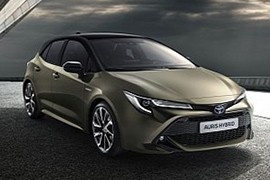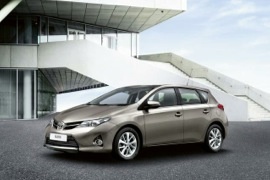
TOYOTA Auris 5 Doors
Generations Timeline, Specs and Pictures

The third generation Auris made its debut at the 2018 Geneva motor show with a more dynamic exterior design and with a brand new 2.0 liter full hybrid powertrain joining the engine lineup, marking the debut of Toyota’s dual hybrid strategy. The new Auris sits on the new TNGA global platform, which will stand as a basis for all future Toyota passenger cars. In the new model there’s a new multilink rear suspension to improve handling, and the high-strength steel in the body shell also contributes to rigidity. The new car is an inch shorter than the outgoing one, but the wheelbase has been lengthened by 1.6 inches.

In 2017, the Toyota Auris went through a mid-life cycle refresh coming with new looks, upgraded safety equipment, and better powertrains.
The biggest visual change can be seen at the front, where the bumper has been completely redesigned to unite the two foglamp surrounds with the lower grille. The upper grille was redesigned as well along with the headlights. The 2015 Auris range further benefits from suspension and steering revisions designed to improve ride comfort, handling and driver involvement. And numerous measures have also been introduced to reduce the transmission of Noise, Vibration and Harshness (NVH) into the cabin.

The 2013 Toyota Auris is the second generation of the nameplate.
The car was previously known as the Toyota Corolla Hatchback. After that, the Japanese carmaker decided to change the name for the hatchback and leave the Corolla only for the sedan version and for some countries. The Auris was criticized for having a bold look in the C-Segment, where all the other manufacturers had tried their imagination.
The 2013 model has a sharper look, with angled headlights and an aggressive design with air scoops on the sides of the front bumper like those usually used for cooling brakes, and a central larger one. The grille is also designed into a V-shape to complete the fascia. The car is not as sporty as it looks, but at least it looks better. Depending on trim level, the Auris was available with steel or light-alloy wheels.
Under the hood there was a range of engines from 1.2-liter to 2.0-liter ones, both gasoline and diesel. The smallest unit was turbocharged and offered 115 hp, while the most powerful unit was the 1.8 with 144 hp. The diesel units were turbocharged with 1.6-liter and 2.0-liter displacement and offered 90 hp and 124 hp, respectively.
Inside the vehicle, there is room for five with a flat floor for the rear passengers. The infotainment system has a USB port for music input or charging the phone.

Toyota introduced at the 2010 Geneva Auto Show the new European-spec Auris.
The car features an updated facelift with redesigned headlamps and taillights, restyled bonnet and front grille and new front and rear bumpers. The interior received a makeover too, Toyota upgrading the quality of the materials and finishes and rearranging the center console for improved ergonomics. With a choice between 3 petrol units and 3 diesel units, all engines benefit from the fuel saving Toyota Optimal Drive technology. Another important addition with the 2010 Auris is the new HSD hybrid version, which is the world’s first full hybrid C segment vehicle.

In 2006, Toyota changed its compact segment lineup and renamed the Corolla hatchback as Auris, while the sedan version kept its original name.
It was a bold move for the Japanese carmaker, which adopted the “-is” to match the same final letters as the other core models such as Yaris or Avensis. Regardless of the car’s name, the compact segment hatchback aimed directly at the Volkswagen Golf, Ford Focus, and Renault Megane.
With the new model, Toyota introduced a fresh, young design language. It featured a front fascia with horizontal lines, which made the car looks wider, sportier. The lower bumper sported a wide center grille with two side scoops on the outer sides. Its angular-shaped headlights resembled those installed on the Avensis and the Yaris but still had their personality. From its sides, the slightly curved body panels gave the car a minimalist design look, but not bland.
Toyota officials stated that the car was designed from inside out, and it looked like that. The interior featured a unique tall center console that was connected to the center stack through a sloped, ascending bridge where the gear-stick (or the gear selector) took center stage. For the multimedia system, the carmaker offered a few choices depending on the trim level named Terra (Earth) for the base level, Luna (Moon) as the mid-level, and Sol (Sun) for the highest level. A navigation system was on the options list. Toyota’s designers said that an airliner cockpit layout inspired them. The front bucket seats were made more on the comfort side, while the rear 60/40 split-folding seatback allowed the user to expand the trunk.
Under the hood, the carmaker installed a choice of seven engines, either gasoline or turbo-diesel. Some of them were available with an automatic gearbox.























































